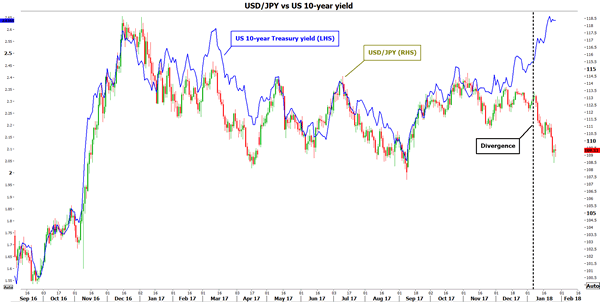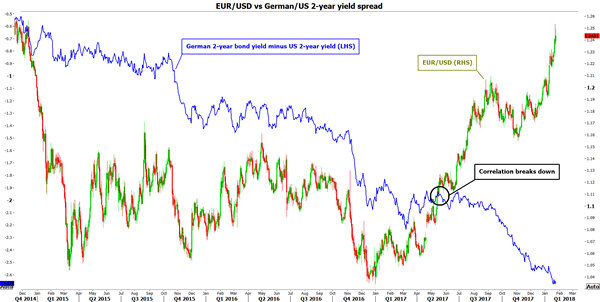A nation’s bond yields and its currency typically move in the same direction. A rise in US Treasury yields, for instance, has traditionally been followed by dollar strength, as higher interest rates make the currency more attractive for international investors. Vice versa, a plunge in bond yields usually spells bad news for a currency, as it becomes less appealing compared to other higher-yielding currencies.
Logically, it follows that when you compare the difference (i.e. the spread) between the yields of two nations and the relevant currency pair, the two charts should look very similar; changes in relative interest rates are one of the biggest factors driving the FX market. Yet, this historical relationship has broken down recently, with the USD seemingly unable to draw support from the upturn in US yields. While 10-year Treasury yields are near their highest point in more than three years, the dollar index has collapsed, trading at three-year lows.

What could be driving this divergence, and what does this imply for the future? More than anything else, it could be a sign that investors’ confidence in US Treasuries is fading, possibly due to concerns about rising deficits and long-term debt sustainability. Note that back in March, the US Congressional Budget Office projected that if current laws remain unchanged, the US debt-to-GDP ratio would skyrocket to 150% by 2047, from 77% at that time. Legislations have changed since then, but for the worse from a debt perspective, as the recent Republican tax package is anticipated to add notably to US deficits and national debt, making the situation even more unsustainable.
Thus, concerned investors may be selling off their US bonds, which causes yields to rise, but for the "wrong reasons". Instead of yields rising because of expectations that the Fed will raise interest rates faster due to the economy performing well, yields are moving higher due to reduced demand for bonds. Adding credibility to this argument is the fact that the biggest foreign buyers of US debt, China and Japan, may be cutting back on their purchases, according to the Treasury’s latest capital flows data. This narrative can also be linked to the recent melt-up in equity markets. It could explain why US equity indices are breaking all-time highs despite stocks being "expensive" by almost all metrics; investors are selling bonds for stocks.
So, US yields are not necessarily rising for "healthy reasons". Meanwhile, the pessimism in the dollar could reflect other factors, such as the recent step-up in protectionist measures by the US administration. Besides NAFTA renegotiations casting a shadow on the US trade outlook, the recent rise in trade tensions between the US and China has significantly increased the risk of a retaliatory trade war. Last but not least, the recent move towards policy normalization by major central banks other than the Fed, such as the ECB, is another factor making the dollar less appealing compared to its counterparts.

Can this dollar-yield divergence continue? History suggests that the correlation will probably return. The question is whether it will be US yields that will turn lower to meet the dollar, or whether the dollar will eventually recover as a response to a continued upturn in yields. On balance, the latter case may be more likely, though one can only speculate as to how long that could take to materialize. Legendary bond investors, such as Bill Gross, are forecasting a sustained rise in yields (or in other words, a bond bear market). If such calls are accurate, then the dollar is unlikely to remain indifferent for too long.
Besides the greenback, such an outcome could have implications for stocks. Assuming yields do continue to move up, then at some point that may begin to weigh on demand for equities, as bonds begin to produce adequate returns to keep investors interested. Thus, if the yield on 10-year Treasuries crosses a certain critical level, we could see the aforementioned ‘selling bonds to buy stocks’ pattern reverse, though that level may still be a long way off.














